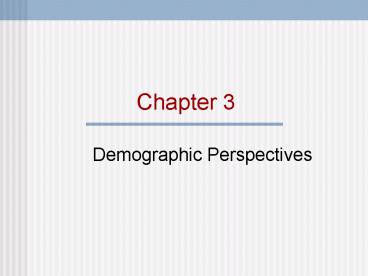Demographic Perspectives - PowerPoint PPT Presentation
1 / 27
Title:
Demographic Perspectives
Description:
St. Thomas Aquinas celibacy is not better than marriage and procreation. ~1280 a.d. ... is preferred way to deal with sexuality; second best is to marry and procreate. ... – PowerPoint PPT presentation
Number of Views:147
Avg rating:3.0/5.0
Title: Demographic Perspectives
1
Chapter 3
- Demographic Perspectives
2
Chapter Outline
- Premodern Population Doctrines
- The Prelude To Malthus
- The Malthusian Perspective
- The Marxian Perspective
3
Chapter Outline
- The Prelude To The Demographic Transition Theory
- The Theory Of The Demographic Transition
- The Demographic Transition Is Really A Set Of
Transitions
4
Population Density of the World
5
Developing a Demographic Perspective
- Two Questions
- What are the causes of population growth (or, at
least, population change)? - What are the consequences of population growth or
change?
6
Premodern Doctrines
7
Premodern Doctrines
8
Premodern Doctrines
9
Modern Theories
10
Modern Theories
11
Modern Theories
12
The Malthusian Perspective
- Malthus argued that people have a natural urge to
reproduce, and the increase in the food supply
cannot keep up with population growth. - The major consequence of population growth,
according to Malthus, is poverty. - Within that poverty is the stimulus for action
that can lift people out of misery.
13
Critiques of Malthus
- Assertion that food production could not keep up
with population growth. - Conclusion that poverty was an inevitable result
of population growth. - Belief that moral restraint was the only
acceptable preventive check.
14
Geometric and Arithmetic Growth
- If we start with 100 acres supporting 100 people
and add 100 acres per decade (arithmetic) while
the population increases 3 per year (geometric)
there will be a few decades of food surplus
before growth overtakes increased cultivation,
producing a food deficit..
15
The Marxian Perspective
- Each society at each point in history has its own
law of population that determines population
growth. - For capitalism, the consequences are
overpopulation and poverty. - For socialism, population growth is readily
absorbed by the economy with no side effects.
16
John Stuart Mill
- Basic thesis was that the standard of living is a
major determinant of fertility levels. - The ideal state is that in which all members of a
society are economically comfortable.
17
Arsène Dumont
- Late 19th century French demographer who felt he
discovered a new principle of population called
social capillarity. - The desire of people to rise on the social scale,
to increase their individuality as well as their
personal wealth. - To ascend the social hierarchy requires that
sacrifices be made.
18
Émile Durkheim
- Based an entire social theory on the consequences
of population growth. - Population growth leads to greater societal
specialization, because the struggle for
existence is more acute when there are more
people.
19
Theory of the Demographic Transition
- Emphasizes the importance of economic and social
development. - Leads first to a decline in mortality and then to
a commensurate decline in fertility. - Based on the experience of the developed nations,
and derived from the modernization theory.
20
The Demographic Transition
- Divided roughly into three stages.
- Birth and death rates are high.
- Transition from high to low birth and death
rates. The growth potential is realized as death
rate drops before the birth rate drops, resulting
in rapid population growth. - Death rates are as low as they are likely to go,
while fertility may continue to decline to the
point that the population might decline.
21
The Demographic Transition
22
Modernization Theory
- Macro-level theory that sees human actors as
being buffeted by changing social institutions. - Individuals did not deliberately lower their risk
of death to precipitate the modern decline in
mortality. - Society wide increases in income and improved
public health infrastructure brought about this
change.
23
Easterlin Relative Cohort Size Hypothesis
- The standard of living you experience in late
childhood is the base from which you evaluate
your chances as an adult. - If you can improve your income as an adult
compared to your childhood level, you are more
likely to marry early and have several children.
24
Demographic Transition A Set of Transitions
- Mortality transition -shift from deaths at
younger ages due to disease to deaths at older
ages due to degenerative diseases. - Fertility transition- the shift from natural (and
high) to controlled (and low) fertility.
25
Demographic Transition A Set of Transitions
- Age transition- social and economic reactions as
societies adjust to constantly changing age
distributions. - Migration transition - Growth in the number of
young people in rural areas will lead to an
oversupply of young people looking for jobs,
which encourages people to leave in search of
economic opportunity.
26
Demographic Transition A Set of Transitions
- Urban transition - begins with migration from
rural to urban areas and morphs into urban
evolution as most humans are born in, live in,
and die in cities. - Family and household transition - brought about
by structural changes that accompany longer life,
lower fertility, an older age structure, and
urban instead of rural residence.
27
Transitions In the Demographic Transitions
Impact on Society










![[PDF] Global Aging: Comparative Perspectives on Aging and the Life Course 2nd Edition Kindle PowerPoint PPT Presentation](https://s3.amazonaws.com/images.powershow.com/10079272.th0.jpg?_=202407160511)




















